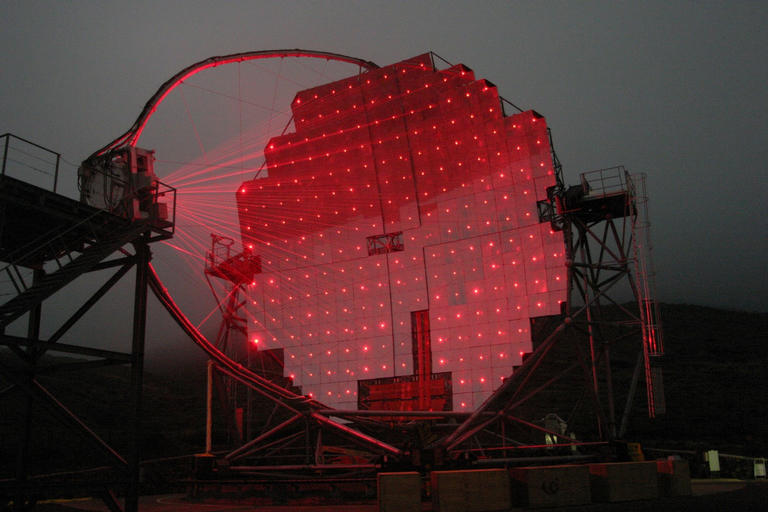|
Cherenkov Array At Themis
The Cherenkov Array at Themis (CAT) was an imaging atmospheric Cherenkov telescope (IACT) for detection of very-high-energy gamma rays (~200 GeV to a few tens of TeV). The project started operation in Autumn 1996 on the site of the former solar plant Thémis, France. References External linksCherenkov Array at Themis (CAT)on the internetTélescope de l'expérience CAT (Cerenkov array at Themis) sur le site de la centrale solaire THEMIS— photo of CAT CATat INSPIRE-HEP INSPIRE-HEP is an open access digital library for the field of high energy physics (HEP). It is the successor of the Stanford Physics Information Retrieval System (SPIRES) database, the main literature database for high energy physics since the 1970 ... database * High energy particle telescopes {{observatory-stub ... [...More Info...] [...Related Items...] OR: [Wikipedia] [Google] [Baidu] |
Imaging Atmospheric Cherenkov Telescope
IACT stands for Imaging Atmospheric (or Air) Cherenkov Telescope or Technique. It is a device or method to detect very-high-energy gamma ray photons in the photon energy range of 50 GeV to 50 TeV. There are four operating IACT systems: High Energy Stereoscopic System (H.E.S.S.), Major Atmospheric Gamma Imaging Cherenkov Telescopes (MAGIC), First G-APD Cherenkov Telescope (FACT), and Very Energetic Radiation Imaging Telescope Array System (VERITAS). The Major Atmospheric Cerenkov Experiment Telescope (MACE) is under construction in Hanle, Ladakh, India and is set to be the highest and second-largest IACT. The Cherenkov Telescope Array (CTA) is a multinational project to build next-generation IACTs and is scheduled to begin data collection in 2022. Background Due to the rapidly falling flux of gamma-ray photons from cosmic sources in this energy regime, space-based detectors become ineffective due to their small collection areas which are often limited to some tens ... [...More Info...] [...Related Items...] OR: [Wikipedia] [Google] [Baidu] |
Very-high-energy Gamma Ray
Very-high-energy gamma ray (VHEGR) denotes gamma radiation with photon energies of 100 GeV ( gigaelectronvolt) to 100 TeV (teraelectronvolt), i.e., 1011 to 1014 electronvolts. This is approximately equal to wavelengths between 10−17 and 10−20 meters, or frequencies of 2 × 1025 to 2 × 1028 Hz. Such energy levels have been detected from emissions from astronomical sources such as some binary star systems containing a compact object. For example, radiation emitted from Cygnus X-3 has been measured at ranges from GeV to exaelectronvolt-levels. Other astronomical sources include BL Lacertae, 3C 66A Markarian 421 and Markarian 501. Various other sources exist that are not associated with known bodies. For example, the H.E.S.S. catalog contained 64 sources in November 2011. Detection Instruments to detect this radiation commonly measure the Cherenkov radiation produced by secondary particles generated from an energetic photon entering the Earth's atmosphere. This method i ... [...More Info...] [...Related Items...] OR: [Wikipedia] [Google] [Baidu] |
Themis (solar Power Plant)
The THEMIS solar power tower is a research and development centre focused on solar energy. It is located near the village of Targasonne, in the department of Pyrénées-Orientales, south of France, 3 kilometres from the world's largest solar furnace in Odeillo. Siting of the plant THEMIS solar power tower, owned by the General Council of the Pyrénées-Orientales, was strategically located in the region of Cerdanya, in the Pyrénées-Orientales, because the conditions are excellent for solar energy. First, Cerdanya has almost 2400 hours of sunshine a year; second, there is a very low wind limiting the time of disruption of the plant; third, the site is at a high elevation providing stronger sunlight. The land chosen for the plant is on a slope between 6° and 18°, which is suitable for a power tower. THEMIS research and development centre Research and development is focused on solar energy, and THEMIS is a research facility as well as a photovoltaic power facilit ... [...More Info...] [...Related Items...] OR: [Wikipedia] [Google] [Baidu] |
INSPIRE-HEP
INSPIRE-HEP is an open access digital library for the field of high energy physics (HEP). It is the successor of the Stanford Physics Information Retrieval System (SPIRES) database, the main literature database for high energy physics since the 1970s. History SPIRES was (in addition to the CERN Document Server (CDS), arXiv and parts of Astrophysics Data System) one of the main Particle Information Resources. A survey conducted in 2007 found that SPIRES database users wanted the portal to provide more services than the, at that time, already 30-year-old system could provide. On the second annual Summit of Information Specialists in Particle Physics and Astrophysics in May 2008, the physics laboratories CERN, DESY, SLAC and Fermilab therefore announced that they would work together to create a new Scientific Information System for high energy physics called INSPIRE. It interacts with other HEP service providers like arXiv.org, Particle Data Group, NASA's Astrophysics Data System. and ... [...More Info...] [...Related Items...] OR: [Wikipedia] [Google] [Baidu] |
